
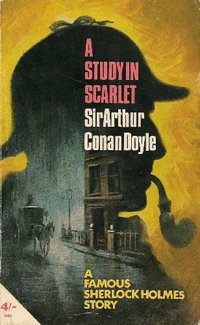 Classics in September — Written in 1886, A Study in Scarlet was the first of four novels and 56 short stories by author Arthur Conan Doyle featuring Sherlock Holmes. It is said that the character of Holmes was inspired by Dr Joseph Bell, a renowned forensic scientist whom Doyle studied under at Edinburgh University. Holmes is without doubt the grandfather of crime fiction detectives and Classics In September wouldn’t be complete without him.
Classics in September — Written in 1886, A Study in Scarlet was the first of four novels and 56 short stories by author Arthur Conan Doyle featuring Sherlock Holmes. It is said that the character of Holmes was inspired by Dr Joseph Bell, a renowned forensic scientist whom Doyle studied under at Edinburgh University. Holmes is without doubt the grandfather of crime fiction detectives and Classics In September wouldn’t be complete without him.
A Study In Scarlet begins with the meeting of Dr John Watson and Sherlock Holmes. Back from the war and running short on funds Watson urgently needs somewhere to stay and whilst talking to a friend it comes to light that a man named Sherlock Holmes is looking for someone to rent a room at 221B Baker Street. Watson and Holmes meet and after Watson is quizzed on his habits and faults to ensure he is a suitable living companion, he is allowed to move in. Watson is amazed by Holmes and his profound knowledge, and Holmes reveals that he is a consulting detective.
A murder investigation is soon underway when the body of a well dressed gentleman is found, with cads his pocket printed with Enoch J Drebber, Cleveland, Ohio, USA. There was no robbery, nor is there any evidence as to how the man met his death. There are marks of blood in the room but no wound upon his person. Above the man’s body the word ‘RACHE’ is written in blood. Detectives Lestrade and Gregson are baffled by the murder so they request the help of Holmes.
Holmes takes one look at the murder scene and deduces the cause of death and a description of the murderer, including his height, shoe size and cigar make. Recovering what appears to be a woman’s a ring from the crime scene, he places an advert in the local paper hoping to catch the murderer. Within a matter of hours an old lady comes for the ring, claiming it belongs to her daughter. Holmes doesn’t believe her so when she leaves he follows her. The old lady somehow manages to outwit Holmes and escape his tail – it seems that the famous Sherlock Holmes is nowhere near cracking the case.
Incapable of passing up a moment to get one over on Holmes, Gregson pays him a visit to gloat that he has found the murderer, a man named Stangerson who was a friend of Drebber’s. Just as Gregson is describing how he came to his conclusions, Lestrade arrives with news that another murder has occurred. The body of Stangerson has been discovered, in his room, with a fatal wound to the heart. And above his body was the word ‘RACHE’. Gregson was wrong in his belief that Stangerson was the murderer and it seems the case is back to square one.
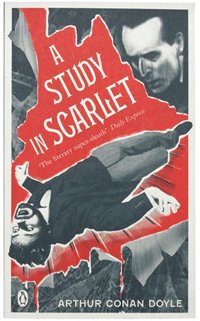 As Lestrade and Gregson are standing there baffled a young beggar hired by Holmes arrives stating that he has got Holmes a cab. Holmes sends him down to fetch the cabby, claiming to need help with his suitcase, however, when the cabby arrives Holmes handcuffs and restrains him, revealing him to be the murderer of Drebber and Stangerson. A man called Jefferson Hope.
As Lestrade and Gregson are standing there baffled a young beggar hired by Holmes arrives stating that he has got Holmes a cab. Holmes sends him down to fetch the cabby, claiming to need help with his suitcase, however, when the cabby arrives Holmes handcuffs and restrains him, revealing him to be the murderer of Drebber and Stangerson. A man called Jefferson Hope.
The story then flashes back to 1847 America where we see a man called John and a young girl called Lucy, the only survivors from a large party of pioneers. John and Lucy are saved by a group of Mormons on their travels on the condition that they adopt and live by the Mormon faith. This turn in the plot seems odd, with no relevance to Holmes and the murder mystery he’s trying to solve. However, stick with it and soon it all ties together. This part of the story provides all the necessary background for the motive of the murders. We then return to the main narrative, where Holmes proves how his powers of deduction helped to find the murderer.
Like all but four of the Sherlock Holmes stories Doyle wrote, A Study In Scarlet is narrated by Dr John Watson. Two of the others are narrated by Sherlock Holmes himself, and the remainder written in the third person. I particularly enjoy the stories told from Watson’s viewpoint. I think we gain an interesting view of Holmes and we can see the relationship between the two gradually grow throughout the novels. For a novel written in 1886 A Study In Scarlet is very easy to follow.
The public’s love of the detective is arguably down to his miraculous powers of deduction. According to the New York Times, the Sherlock Holmes novels are the third most read publications on the planet behind the Bible and the Dictionary. The character Holmes has been portrayed in many films and TV shows since his first appearance in the 1886 novel. The detective first appeared on the big screen as early as 1899, but perhaps the most notable cinematic rendition of Holmes was the series of 14 films starring Basil Rathbone as Holmes between 1939 and 1946. Peter Cushing and Jeremy Brett have also made excellent renditions of the character. Most recently we have seen modernised versions of Holmes in the BBC series starring Benedict Cumberbatch, and the blockbuster movies directed by Guy Ritchie with the detective played by Robert Downey Jr.
Cumberbatch is my favourite Holmes, and although the series is obviously set in modern day London I would argue that, as Holmes, Cumberbatch is not far off Doyle’s 19th century creation. Not only does he fit the description of Holmes as ‘rather over six feet tall and so excessively lean that he seemed to be considerably taller’ but he also accurately portrays his mannerisms and deductive capabilities. The same can’t be said for the Guy Richie movies. These focus too much on the action and violence, turning the character into a period action hero. This isn’t to say that the movies aren’t entertaining, and indeed Holmes is portrayed in many of the novels as a good fighter.
In recent years, Sherlock Holmes has become a public domain character and has featured in many books by a variety of authors trying their hand with Conan Doyle’s sleuth. One of the latest is House of Silk by Anthony Horowitz, which we’re going to look at in a few days here as part of Classics in September. In the meantime, A Study in Scarlet is a great place to start if you’ve left Holmes on the backburner until now.
You can download A Study in Scarlet free – it is out of copyright – from the Gutenburg Project here, or order a Kindle version with extras, compilation or DVD below…
You can watch the entire 71 minute 1933 film version of A Study in Scarlet starring Reginald Owen as Sherlock Holmes from The Video Cellar below:






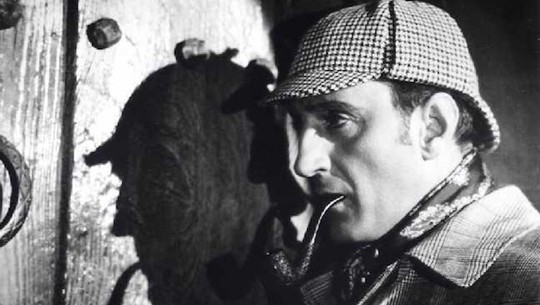
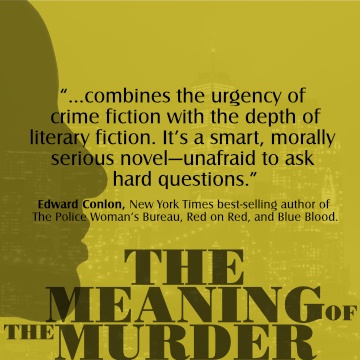

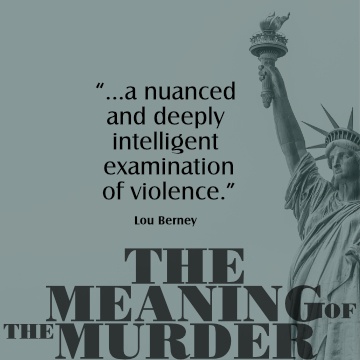
Thanks for the awesome post. I read this last year but I’ve been negligent on catching up with the other ones.
I have to admit that I wish the flashback to 1847 was a bit shorter, but I can see how it is important to the plot. I think it’s very interesting that they are the 3rd most read books in the world.